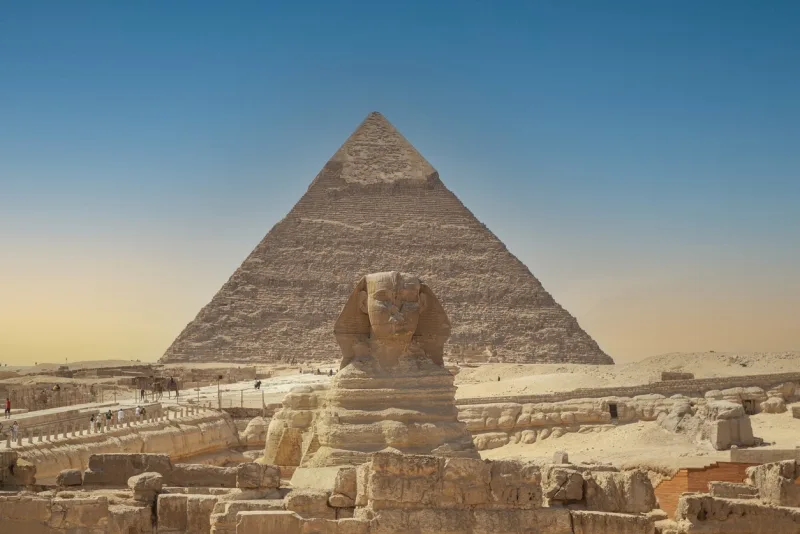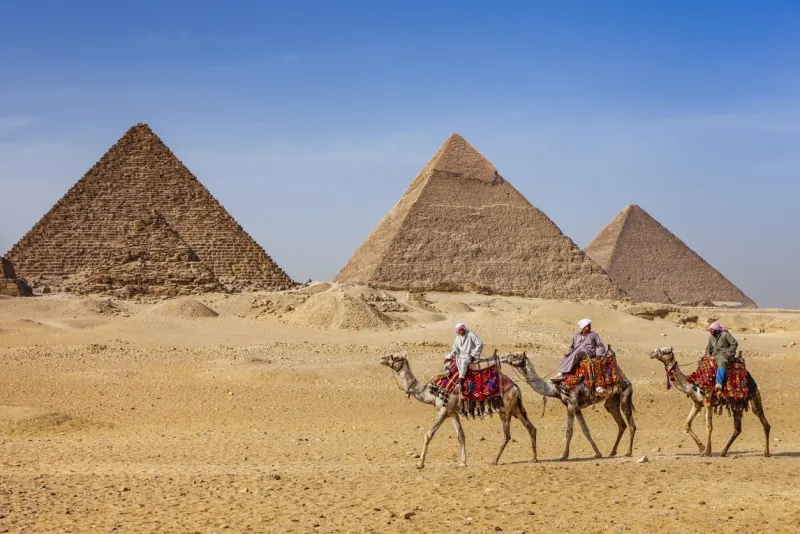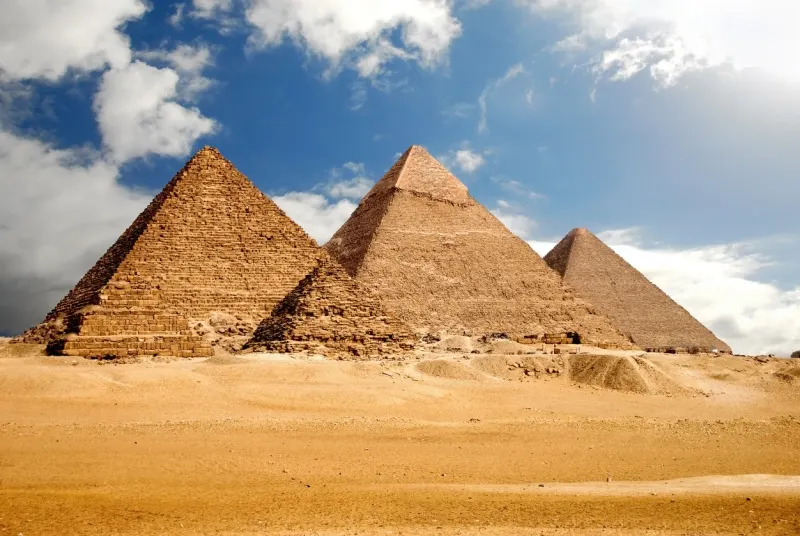Egypt Pyramids Facts
.jpg)
Rising from Egypt’s desert plateau, the Pyramids of Giza stand as one of humanity’s greatest architectural wonders. Built during the 4th dynasty for the pharaohs Khufu, Khafre, and Menkaure, these monuments have endured for over 4,000 years. The Great Pyramid of Khufu alone required millions of stone blocks and remains history’s most ambitious construction project. While ancient accounts suggested 100,000 laborers built it, modern archaeology reveals a smaller, skilled workforce of around 20,000, supported by craftsmen and specialists—showcasing the remarkable organization of ancient Egyptian society
The Giza Pyramids: A Monumental Feat
Even after 4,500 years, the Pyramids of Giza still amaze the world, showcasing how the ancient Egyptians achieved what even modern construction struggles to match—without using advanced tools.
Scale and Precision of the Structures
Khufu’s Great Pyramid once stood 146.6 meters tall, making it the world’s tallest structure for nearly 3,800 years. Built with millions of tons of limestone, granite, and mortar, it remains a symbol of ancient ambition. What amazes researchers most is its precision—stone joints as narrow as 0.5 mm, sides differing by only centimeters, and a base squared with near-perfect accuracy, achievements that rival even modern construction standards.
Geographic and Astronomical Alignment
The Pyramids of Giza show remarkable astronomical precision. Khufu’s pyramid aligns almost perfectly with the cardinal directions, likely using equinox shadows or star observations for guidance. Solar alignments also play a role: from the Sphinx, the sun sets over Menkaure’s pyramid at the winter solstice and between the larger pyramids at the summer solstice. These features reveal the builders’ advanced knowledge of both architecture and astronomy.

Uncovering the Workforce Behind the Pyramids
Archaeology shows the pyramids were built not by enslaved masses but by organized, skilled Egyptian workers, as evidence reveals well-structured and supportive communities behind their construction.
Who Were the Builders?
The pyramid builders were Egyptians, not foreign slaves. Cemeteries reveal 20,000–30,000 workers, with about 4,000 handling stonework and the rest providing support. Their workforce was highly organized into crews, gangs, and small specialized teams, often adopting proud names like “Friends of Khufu,” reflecting both skill and national dedication.
Living Conditions in Worker Villages
Excavations by Mark Lehner and Zahi Hawass uncovered a workers’ settlement near the pyramids, showing how laborers lived during construction. The town had barracks, streets with drainage, and both permanent homes and temporary camps. Housing reflected social rank—skilled workers had better quarters with storage and courtyards, while laborers lived communally. All were paid in bread and beer, with higher rations for supervisors that fueled internal trade.
Support Systems: Bakers, Medics, and Priests
Supporting the pyramid workforce required vast infrastructure, including copper workshops, bakeries, and fish-processing sites. Workers had rich diets with beef, pork, and poultry. Evidence of advanced medical care—like treated fractures and even a successful leg amputation—shows their high status. Religious life was also central, with cemeteries containing both simple and decorated tombs that reflected their spiritual importance in Egyptian society.

Recent Archeological Discoveries
Ongoing excavations in Egypt keep uncovering new evidence about the pyramid builders, challenging old theories and offering deeper insight into their construction methods and daily lives.
New Tombs and Burial Artifacts
Excavation teams recently revealed three tombs from the New Kingdom period (1550-1070 B.C.) near Luxor, each telling distinct stories of ancient Egyptian life. Among them lies the resting place of Amum-em-Ipet, who dedicated his service to Amun's temple, alongside Baki, who oversaw grain storage operations, and a third individual known only as 'S'—a remarkable figure who served simultaneously as temple supervisor and mayor of northern oases. These burial sites showcase elaborate architectural features: courtyards leading to corridors that culminate in ceremonially significant burial chambers. Meanwhile, the ancient site of Abydos yielded an extraordinary find—a massive tomb dating back 3,600 years, constructed nearly 23 feet below ground with impressive 16-foot vaulted chambers built entirely from mud bricks.
Tools and Construction Equipment Found
Excavation sites surrounding the pyramids have revealed the actual implements used by ancient builders. Teams discovered flint tools alongside construction stones, providing tangible connections to the building process. Perhaps more significantly, archaeologists located a limestone quarry positioned just 1,000 feet from the Great Pyramid, where remnants of rubble and mud ramps still bear witness to the stone transportation system. These ramp discoveries challenge previous assumptions about construction methods—evidence now suggests builders used dramatically steeper inclines than researchers once believed possible, with grades exceeding 20 percent rather than the previously assumed 10 percent maximum.
Hieroglyphs and Graffiti by Workers
The most captivating discoveries emerge from within the pyramid structures themselves, where ancient workers left their marks for posterity. Hidden within Campbell's Chamber inside the Great Pyramid, hieroglyphic graffiti declares "The gang, Friends of Khufu," offering an intimate glimpse into worker identity and pride. Additional inscriptions reveal specific job titles—"overseer of the side of the pyramid" and "craftsman"—carved directly into the monument's inner walls. At the Red Sea site of Wadi al-Jarf, researchers uncovered papyrus logbooks maintained by a 160-member work crew responsible for transporting stones from Tura quarries directly to Giza.
Digital Mapping and 3D Scans
Modern technological approaches have opened entirely new avenues for pyramid exploration without disturbing these ancient structures. The ScanPyramids project employs sophisticated muon detection methods to identify previously unknown internal spaces, achieving notable success with the 2017 discovery of a substantial cavity positioned above the Grand Gallery.
Parallel research using ground-penetrating radar has revealed an ancient Nile branch stretching 64 kilometers, which bordered 31 different pyramids and likely served as the primary transportation route for construction materials. Digital reconstruction initiatives, including the "Great Pyramid in 3D" project, now provide virtual access to these monuments with unprecedented detail and accuracy.

Customize Your Dream Vacation!
Get in touch with our local experts for an unforgettable journey.
Plan Your Trip
Changing Our Understanding of Ancient Egypt
Modern archaeological work continues to dismantle centuries-old assumptions about Egypt's most famous monuments. These pyramid investigations have revealed a civilization far more sophisticated than historical accounts suggested, fundamentally altering scholarly perspectives on ancient Egyptian capabilities and social structures.
Debunking the Slave Labor Myth
Evidence from excavation sites has definitively shattered the enduring myth of enslaved pyramid builders. Worker burial sites discovered near the sacred monuments tell a markedly different story—these individuals received honorable interment befitting valued contributors to pharaonic projects. Such treatment stands in stark contrast to what enslaved populations would have experienced. Historical dramatizations and Herodotus's ancient writings painted misleading pictures of the construction reality.
Archaeological findings reveal these builders came from poor Egyptian families who received compensation for their efforts. Daily provisions included substantial quantities—21 cattle and 23 sheep delivered regularly—demonstrating the high regard Egyptian society held for these workers.
Reevaluating Ancient Engineering Skills
Scientific investigations have unveiled engineering sophistication that challenges traditional views of ancient technological limitations. The discovery of the Ahramat Branch reveals how the Nile served as an ancient transportation network, creating efficient pathways for moving construction materials to pyramid sites.
More remarkable still, evidence points to advanced hydraulic systems that may have facilitated pyramid construction through innovative water-powered mechanisms. Research indicates these systems possessed the theoretical capacity to move up to 100 tons simultaneously—capabilities that force reconsideration of what ancient civilizations could achieve without modern machinery.
Cultural and Social Implications
Documentary evidence like the Merer Papyrus illuminates the complexity of pyramid construction organization. These ancient records detail specific work crews—the "Great Company" and "Corps of Heroes"—along with precise documentation of their daily bread and beer allocations. Tomb inscriptions bearing titles such as "Chief of Transport Workers" further demonstrate the hierarchical sophistication underlying these massive projects.
The pyramid construction process emerges not as brute forced labor, but as a coordinated effort that combined architectural mastery, organizational excellence, and religious devotion—elements that collectively defined the essence of ancient Egyptian civilization.

When you visit the Pyramids of Giza near Cairo, it’s easy to wonder who built these colossal monuments. Contrary to popular belief, the pyramids were not built by slaves. Archaeological evidence shows they were constructed by a skilled workforce of around 20,000–30,000 Egyptian citizens. These included craftsmen, stonecutters, and laborers, as well as support staff like bakers, brewers, and medics. If you explore the nearby workers’ village on the Giza Plateau, you’ll see the remains of their homes and workshops, which give you a glimpse into their daily lives.
The Great Pyramid of Khufu is one of the most precisely aligned monuments in the world. Its base is nearly perfectly oriented to the four cardinal directions, deviating by just 3 minutes and 38 seconds of arc on average. When you stand before it, you’ll realize this level of precision reflects the ancient Egyptians’ advanced knowledge of astronomy and engineering. It’s one of the many reasons the pyramids remain a highlight of most Egypt tours in Cairo.
In recent years, archaeologists have uncovered fascinating evidence that reshapes how we think about pyramid building. Excavations revealed workers’ villages, tools, ramps, and even hieroglyphic graffiti left behind by construction teams. These findings show how organized and skilled the labor force was. Modern mapping technology has also allowed researchers to study hidden chambers and passageways, giving visitors on Giza tours even more reason to marvel at these structures.
If you’ve ever wondered how massive stones were moved, new research suggests the Egyptians used a now-extinct branch of the Nile River that once flowed near the pyramid sites. This natural waterway acted like a “highway,” allowing boats to transport heavy limestone blocks closer to Giza. From there, sophisticated ramp systems helped move the stones up the pyramid structure. When you tour the site, guides often explain these ingenious methods, which highlight the brilliance of ancient Egyptian engineering.
Life for pyramid builders was far from harsh slavery—it was organized and surprisingly supportive. Archaeological evidence shows that workers had housing, medical care, and access to religious practices. They received daily rations of bread, meat, and beer as payment for their labor, and the work crews were structured hierarchically, much like modern teams. When you explore the workers’ cemetery and settlement near Giza, you’ll see proof that these builders were valued contributors to Egypt’s greatest monuments.














